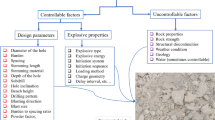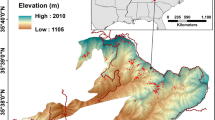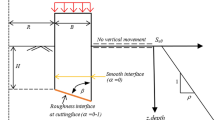Abstract
Rock fragmentation size distribution is often used as an important index to account for the blasting effect because it directly affects the subsequent loading, transportation, and secondary crushing. Due to the mismatching of explosive and rock wave impedance, high boulder yield often occurs which affects the blasting effect. In this study, methods of measuring rock acoustic impedance, rock strength point loading, and detonation wave velocity have been used to obtain more accurate input parameters. Then, in the watershed image segmentation technique, the Gates-Gaudin-Schuhmann and Rosin-Rammler distribution functions have been used to analyze and quantitatively describe the rock fragmentation size distribution in the existing muck-pile. Finally, taking the rock properties, explosive performance, blasting parameters, and system characteristic variable into consideration, support vector machine (SVM) regression model has been analyzed on the learning and prediction of samples. The results show that SVM has a good prediction accuracy, high precision, and strong generalization ability. The optimized matching coefficient of rock and explosive wave impedance K ranges from 2.50 to 2.58 times. This study has developed a series of simple, accurate methods for rock properties analysis, detonation wave velocity measurement, and muck-pile model image processing, and a basis for predicting and evaluating rock fragmentation size distribution and optimizing the matching coefficient before carrying out a blasting operation.








Similar content being viewed by others
References
Bakhtavar E, Mahmoudi H (2020) Development of a scenario-based robust model for the optimal truck-shovel allocation in open-pit mining. Comput Oper Res 115
Faramarzi F, Mansouri H, Ebrahimi Farsangi MA (2013) A rock engineering systems based model to predict rock fragmentation by blasting. Int J Rock Mech Min 60:82–94
Drake B, Koroznikova L, Tuck M, Durkin S (2020) Application of thermal fragmentation in Australian hard rock underground narrow-vein mining. Min Metall Explor 37:219–229
Singh BK, Mondal D, Shahid M, Saxena A, Roy PNS (2019) Application of digital image analysis for monitoring the behavior of factors that control the rock fragmentation in opencast bench blasting: a case study conducted over four opencast coal mines of the Talcher Coalfields, India. J Sustain Min 18:247–256
Bakhtavar E, Khoshrou H, Badroddin M (2015) Using dimensional-regression analysis to predict the mean particle size of fragmentation by blasting at the Sungun copper mine. Arab J Geosci 8:2111–2120
Shi X, Zhou J, Wu B, Huang D, Wei W (2012) Support vector machines approach to mean particle size of rock fragmentation due to bench blasting prediction. T Nonferr Metal Soc 22:432–441
Kulatilake PHSW, Qiong W, Hudaverdi T, Kuzu C (2010) Mean particle size prediction in rock blast fragmentation using neural networks. Eng Geol 114:298–311
Tang Y, Xu Q, Ke B, Zhao M, Cai X (2018) Study on optimization of SVM model of rock blasting fragmentation based on cross-validation. Chin J Blast 35:74–79
Haowen Z (2019) Blasting fragmentation prediction based on BFO-LSSVM algorithm. Wuhan, Changjiang River Scientific Research Institute
Aler J, Du Mouza J, Arnould M (1996) Measurement of the fragmentation efficiency of rock mass blasting and its mining applications. Int J Rock Mech Min Geo Abstracts 33:125–139
Vapnik V (1996) The nature of statistical learning theory. Springer-Verlag, New York
Zhou J, Li XB (2011) Evluating the thickness of broken rock zone for deep roadways using nonlinear SVMs and multiple linear regression model. Procedia Eng 26:972–981
Okwuashi O, Ndehedehe CE (2020) Deep support vector machine for hyperspectral image classification. Pattern Recogn 103:107298
Trivedi R, Singh TN, Raina AK (2014) Prediction of blast-induced flyrock in Indian limestone mines using neural networks. J Rock Mech Geotech Eng 6:447–454
Román-Sánchez A, Willgoose G, Giráldez JV, Peña A, Vanwalleghem T (2019) The effect of fragmentation on the distribution of hillslope rock size and abundance: insights from contrasting field and model data. Geoderma 352:228–240
Petrosyan MI (1994) Rock Breakage by Blasting. A.A.Balkema
Yang XL (1991) Study of blasting stress, size and matched impedance between explosive and rock. J China Coal Soc 1:89–96
Gu W, Wang Z, Chen J, Liu J, Lu M (2015) Experimental and theoretical study on influence of different charging structures on blasting vibration energy. Shock Vib 2015:1–11
Yang H, Duan H, Zhu J (2020) Effects of filling fluid type and composition and joint orientation on acoustic wave propagation across individual fluid-filled rock joints. Int J Rock Mech Min 128:104248
Nateghi R (2011) Prediction of ground vibration level induced by blasting at different rock units. Int J Rock Mech Min 48:899–908
Lu SS (2012) Research dynamic response and failure mode of tunnel surrounding rock under blasting loading. Tianjin University, Tianjin
Pirpanahi M, Palassi M (2013) Using the point load test to determine the uniaxial compressive strength of marble and travertine rocks. In: The 1th Iranian conference on geotechnical engineering. Ardabi, Iran: Universtiy of Mohaghegh
Rusnak JA, Mark C Using the point load test to determine the uniaxial comressive strength of coal measure rock. Mater Sci
Leng Z, Fan Y, Gao Q, Hu Y (2020) Evaluation and optimization of blasting approaches to reducing oversize boulders and toes in open-pit mine. Int J Min Sci Technol 30:373–380
Li KB, Li XJ, Yan HJ, Wang XJ, Wang Y (2018) Study of continuous velocity probe method for the determination of the detonation pressure of commercial explosives. J Energ Mater 36:377–385
Li KB, Li XJ, Yan HJ, Wang XJ, Miao YS (2017) A velocity probe-based method for continuous detonation and shock measurement in near-field underwater explosion. Rev Sci Instrum 88:123905
Yen YK, Lin CL, Miller JD (1998) Particle overlap and segregation problems in on-line coarse particle size measurement. Powder Technol 98:1–12
Chimi-Chiadjeu O, Le Hégarat-Mascle S, Vannier E, Taconet O, Dusséaux R (2014) Automatic clod detection and boundary estimation from digital elevation model images using different approaches. Catena 118:73–83
Vincent O, Folorunso O (2009) A descriptive algorithm for sobel image edge detection. Informing Science + IT Education Conference
Miao Y (2018) Research on blasting technology of converging detonation wave collision. Dalian University of Technology, Dalian
Bankman I (2000) Handbook of medical imaging: processing and analysis management. Academic Press, Salt Lake City
Khandelwal M (2010) Evaluation and prediction of blast-induced ground vibration using support vector machine. Int J Rock Mech Min 47:509–516
Hesam D, Nima B, Farid A, Mokhtar K (2020) Blast-induced rock fragmentation in wetholes. Min Metall Explor 37:743–752
Shao M, Wang X, Bu Z, Chen X, Wang Y (2020) Prediction of energy consumption in hotel buildings via support vector machines. Sustain Cities Soc 57:102128
Xiao J, He C, Wang S (2014) A classifier ensemble model based on GMDH-type neural network for customer targeting. Springer, Berlin Heidelberg
Xu L, Wang X, Lu B (2020) Probabilistic SVM classifier ensemble selection based on GMDH-type neural network. Pattern Recogn 106:1–11
Acknowledgements
The authors wish to thank the Dexing copper mine management for their appreciation and support.
Funding
The authors also acknowledge the financial support provided by the Natural Science Foundation of Shandong Province of China (No. ZR2019BA023), National Natural Science Foundation of China (Nos. 51879135 and 52604004), and Taishan Scholars Program (2019KJG002, 2019RKB01083).
Author information
Authors and Affiliations
Corresponding author
Ethics declarations
Conflict of Interest
The authors declare no competing interests.
Additional information
Publisher’s Note
Springer Nature remains neutral with regard to jurisdictional claims in published maps and institutional affiliations.
Rights and permissions
About this article
Cite this article
Miao, Y., Zhang, Y., Wu, D. et al. Rock Fragmentation Size Distribution Prediction and Blasting Parameter Optimization Based on the Muck-Pile Model. Mining, Metallurgy & Exploration 38, 1071–1080 (2021). https://doi.org/10.1007/s42461-021-00384-0
Received:
Accepted:
Published:
Issue Date:
DOI: https://doi.org/10.1007/s42461-021-00384-0




